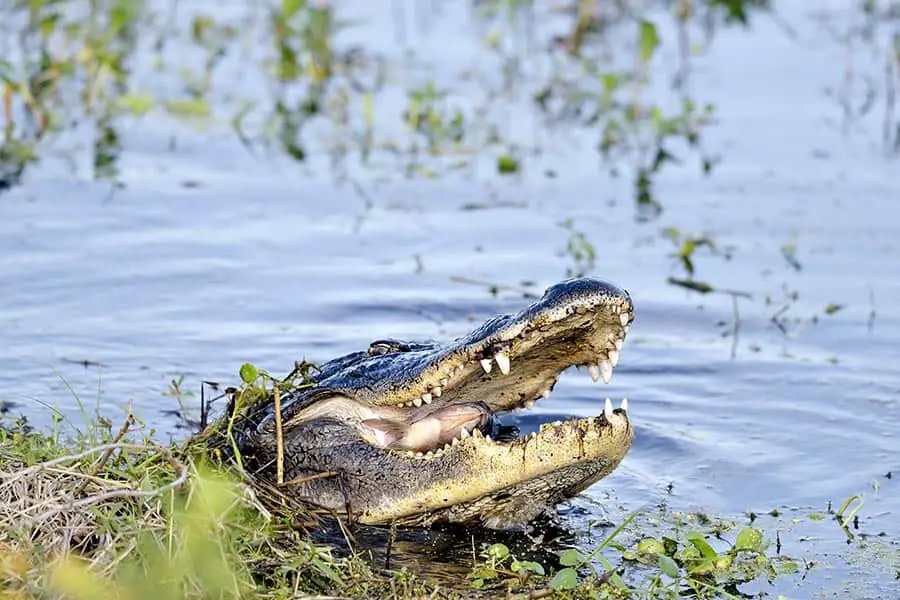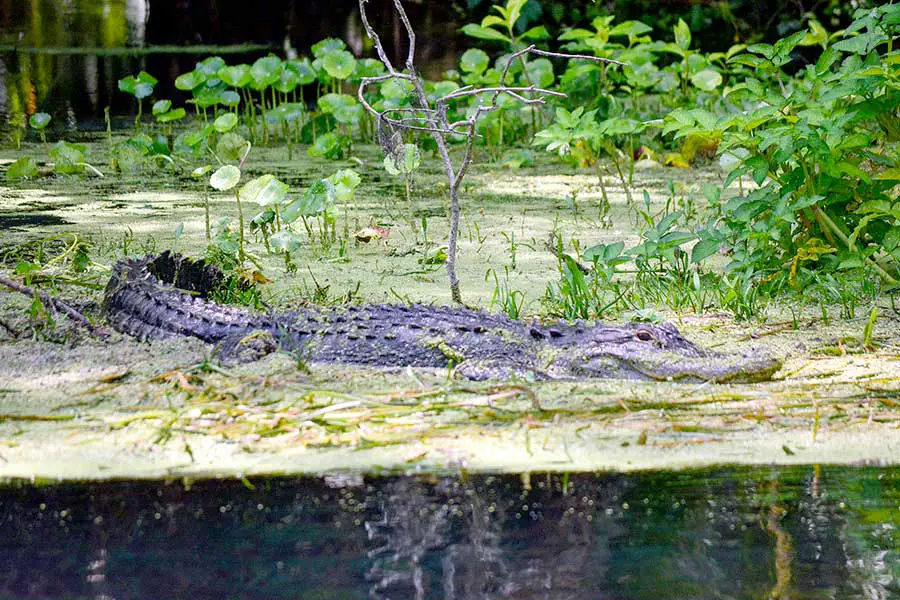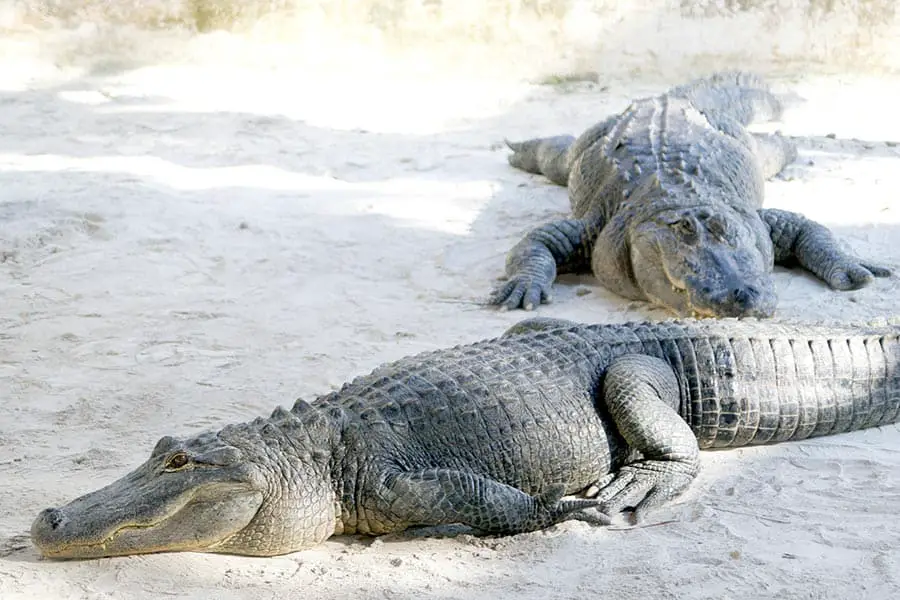
Florida is well known for the large, green, carnivorous reptiles which can be found frequenting the waterways and golf courses of the Sunshine State. The alligator is an unofficial mascot of the state and is, in fact, the official mascot of the University of Florida. But are there only alligators in Florida, or are there crocodiles too?
Florida hosts both alligators and crocodiles. Alligators are mostly found in fresh water, but they do occasionally make their way to inlets and areas where fresh water and salt water meet. On the other hand, crocodiles are mostly found in brackish water near the coasts in South Florida.
But what exactly is the difference between alligators and crocodiles? Aren’t they both the same? Both are big toothy reptiles with reputations for lurking in the water, but they are distinctive and unique creatures beyond the superficial similarities. Read on to learn more.
Alligators and Crocodiles: See You Later or In a While?
Are alligators and crocodiles even related? Yes. Both belong to the taxonomic order Crocodylia but are in different families. Crocodiles and caiman are members of the Crocodylidae family, while alligators belong to the family Alligatordae. Alligators in the United States belong to the species A. Mississippiensis and are cousins of the Yangtze river alligators A. Sinensis.
So what are some of the differences between alligators and crocodiles? Let’s start by comparing their bodies. At a glance, they’re the same, so we must look closer. The easiest way to discern a gator from a croc is by examining the snout. Note: please examine snouts at a safe distance, ideally through binoculars. Both of these animals are potentially hazardous to human beings up close.

Alligators boast a long, rounded, U-shaped snout. The U-shape of the alligator’s jaw allows it to deliver a more powerful closing bite, useful for consuming challenging prey like turtles. When a gator’s mouth is closed, you can’t see their teeth. On the other hand, crocodiles have longer, narrower, V-shaped snouts that show off the croc’s dentition even when their mouths are closed.
Are they the same size, or is one of these reptiles bigger than the other? As it happens, both alligators and crocodiles are huge. Alligators can grow to more than 15 feet in length and weigh an average of 500 pounds. The largest gator on record in Florida weighed 1,043 pounds, more than half a ton! But, gargantuan as gators might get, crocodiles grow larger and can weigh as much as 2,200 pounds.
Where in Florida can one find these beasts? Alligators can be found anywhere in Florida, but they prefer freshwater environments. In fact, a rule of thumb in Florida is that any body of freshwater – a retention pond, a lake, a water hazard on the golf course – may contain an alligator. Floridians have been known to find alligators in storm drains, drainage canals, and swimming pools. If you want to see an alligator in their natural habitat, local nature preserves are great places to look.
What should you do if you encounter an alligator somewhere? If you ever find a gator in Florida, do not approach, touch, or otherwise bother the alligator. If you are in a park or preserve, admire it from a distance and leave it alone. However, if it is in or around your residence, vehicle, workplace, or another public spot, call law enforcement to have the gator removed by animal control. They are beautiful, but hazardous neighbors.
How about crocodiles? Crocodiles are not as common in Florida as alligators. To find crocodiles, you’ll need to travel to South Florida and head for the Everglades. American Crocodiles prefer brackish or salty water and like to linger in coastal swamps, mangrove stands, coves, and ponds. However, they have occasionally been spotted in fresher waters thanks to the extensive and interconnected network of canals in South Florida.
Other Posts of Interest
- Can You Drive On The Beach In Florida?
- Are Sturgeon Protected In Florida?
- Are There Wild Hogs In Florida?
- Is St. Augustine, Florida Worth Visiting?
Phenomenal Florida Fun Fact: Crocodiles and alligators were built to survive prolonged periods of hardship: these amazing reptiles can go up to two years without eating.
If you should encounter a crocodile in Florida, follow the same rules as with an alligator and leave it alone. If it is being a nuisance, e.g., hissing or lunging, contact law enforcement to have the croc trapped. As South Florida’s human population expands, contact between humans and crocs is becoming more frequent. Be vigilant and do not attempt to scare, cajole, or otherwise interact with crocodiles.
Crocodiles and alligators are ambush predators. An ambush predator means that they hunt by stalking prey and waiting for an opportunity to snatch it. Usually, they will lurk in the water and slowly approach a vulnerable prey animal. Then, when the time is right, they will snatch it, crush it with their powerful jaws, and death roll it.
Once the prey is deceased, the reptiles will swallow large chunks of it whole and then go relax. Crocs and alligators eat about once a week.
What do these modern megafauna like to eat? In short, anything they can fit in their mouths. Thus, they will eat turtles, fish, other crocodiles and alligators, birds, small mammals, and even deer.
Alligators and crocodiles will eat pets and small children and have been known to kill adult humans. Therefore, they are extremely hazardous and should be treated with respect and caution.
Are Crocodiles More Dangerous Than Alligators?

Crocodiles are considered more dangerous than alligators. For all their bristle and brawn, alligators are usually not aggressive toward human beings and tend to avoid or ignore people. Generally, they flee from humans rather than attacking. However, alligator attacks on humans are often associated with human behavior.
Widely considered to be some of the most dangerous animals on the planet, crocodiles are known to be more aggressive than alligators. Some people have reported unprovoked crocodile attacks in places like Australia, but luckily for us Floridians, the crocodile species found in the United States are timider than their cousins and also tend not to attack human beings unless provoked.
Are Alligators Endangered?
Once upon a time, alligators were hunted almost to extinction. The loss of any animal from an ecosystem is a tragedy, no less so with alligators. The species was placed on the endangered species list and made a remarkable comeback. In 1987, they were removed from the endangered species list. They are now considered threatened, but under regulations, they can be hunted, and their eggs can be gathered.
How Can I See an Alligator?
To see an alligator in Florida, you just need to go outside. Most Florida cities have a park, stream, river, pond, or lake that has alligators. Sometimes you can see them sunning or basking. You can find them lurking by looking for long, floating objects that resemble logs in the water. You can also see them at many wildlife encounter parks.
Are Crocodiles Endangered?
Like the alligator, the American Crocodile is considered threatened. For some time, crocodile hides were considered highly valuable, which drove a lucrative croc-hunting business in Florida. The species is now protected, but illegal hunting and overdevelopment of South Florida’s wetlands are now the biggest threats to the American Crocodile.
How Can I See a Crocodile?
One of the best ways to see a crocodile is to find a local zoo or marine park with a captive specimen. Places like Gatorland and Croc Encounters let you experience these remarkable animals in a safe way. However, to see a crocodile in the wild, head to the Everglades and hike into the mangroves. This option is an activity that requires careful planning and can be hazardous for a lot of reasons.
Crocodile and Alligator Safety Tips

Even though alligators and crocodiles live in Florida, they are not that much of a threat to the average Floridian. Unprovoked attacks on human beings by alligators and crocodiles are pretty rare. On average, only about one person every three years is killed by a gator or croc in Florida. So your specific risk of being injured by one of these creatures is pretty low.
To keep it low:
- Remember that they are dangerous animals who should be respected.
- Leave them alone.
- Do not feed them.
- If you encounter one, do not approach it.
- Admire them from a distance and treat them with respect.
Following those simple guidelines is a great way to make your risk of an alligator- or crocodile-induced injury almost zero.
When walking a dog or small animal near a body of water, keep your pet leashed. Small children should be held firmly by the hand when walking near fresh water. Alligators and crocodiles both tend to avoid humans, so make noise while walking to alert them to your presence.
If you have a swimming pool, install a screen house to keep intrusive reptiles out of your oasis. If you participate in freshwater sports, e.g., water skiing, be vigilant and use hand signals to communicate with your tow boat.
The Tail End
Alligators and crocodiles are awesome creatures, and both of them call the Sunshine State home. Crocs strongly prefer the heat and environment of South Florida, and gators can be found anywhere in the state.
These animals are emblematic of Florida in many ways: hardy and tough, yet beautiful and serene in their own way. Floridians couldn’t ask for better creatures to share a state with.





